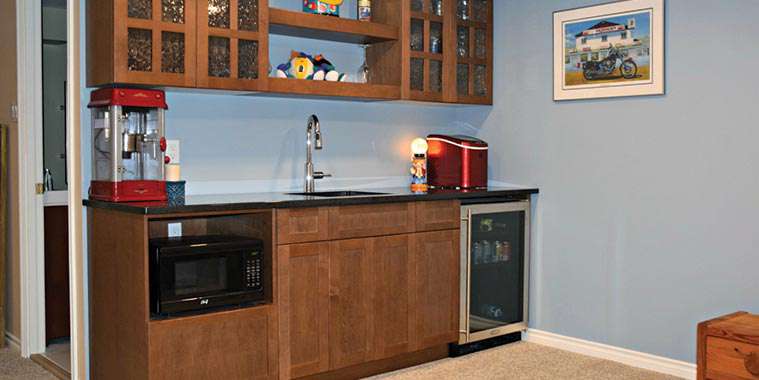By Angie Kendel
Winter seems to be the favorite time of the year to renovate basements. Whether we are looking at developing an unfinished space or updating an older finished space, basement renovations are in high demand! Basements can almost double the living space of a home adding much needed usable space for many families. There are some key elements to keep in mind when planning your new space.
Do you want an open concept finished space or areas with defined use? Who will be using the space? What are their ages? Do they have any special needs/requests? A TV area is very common in a lower level, often for larger screen TVs for watching sports/movies. Most lower level renovations request a built-in fireplace, either gas or electric. Exercise rooms or areas are quite common in many lower level developments. Having a game or play area for children, teens or adults is another common request. Additional office space, or spare bedrooms for family or guests is usually on the list. A small bar or kitchen area allows for convenience of snacks without having to worry about carrying things up and down stairs. Many basement wet bars/kitchens have the ability for meals and snacks to be prepared in the lower level. Finally, most basements projects include a full bathroom for convenient use in the lower level.
Entertainment areas can simply be a wide-open space for a large screen TV or we might be looking at a theatre room the whole family can enjoy. Sound systems can be customized for the space, with ability to use specialized acoustic materials to minimize noise to other areas of the home. This is particularly important for a man cave or theatre room. In my experience, most customers still prefer carpet in the main rec room area. Seating must be planned out for how the space will be used and ensure we have adequate seating for everyone in the space.
If younger children are to have a play area, visual sight lines to keep on eye on the kids while entertaining friends is a must. Having the bar/ kitchen incorporated into the sitting area allows for a great and convenient entertainment space. It’s important to ensure we have adequate seating as well as a comfortable traffic flow pattern for family and guests to comfortably move throughout the space. If adding a fireplace, a permit is required for gas fireplaces. Electric fireplaces do not require a permit. There are many stone or tile options to create a feature statement of your fireplace area. Fireplaces add warmth as well as visual interest in a lower level development.
Exercise areas usually need to be planned out around the type of exercise the family does. Does the space need a TV? A universal gym? Free Weights? An area for floor exercises or maybe they prefer machines like treadmills, ellipticals, and stair climbers? We need to ensure the ceiling height accommodates the height of the person using the machine. Do they want to have an open space to the rest of the basement or a closed off area so they can have privacy? Will more than one person use the space at a time? We don’t want a space too crowded where one person interferes with the other’s exercise program. We need to ensure everyone can move around comfortably and use the space with ease. Flooring is typically different in this area than the rest of the basement but can depend on the exercises the family prefers.
Bedrooms and offices are common additions. Keep in mind if you are using a room in a lower level as a bedroom it must have a window with a means of egress in case of fire. There are specific sizes and requirements in building code that must be followed to ensure it can be “classified” as a proper basement bedroom. If it does not have the necessary egress window it will typically be labelled an “office,” if the home is being sold.
Bathrooms can be difficult to add if there are no existing plumbing lines. It sometimes requires the concrete floor to be removed where plumbing lines need to be added so that the proper plumbing lines can be run and tied into the main plumbing stack of the home. Although, we can plan a bathroom almost anywhere, it always makes sense from a cost perspective to keep the bathroom below an existing bathroom or kitchen to minimize the cost of plumbing. Permits should be pulled for any new plumbing or electrical work. If you are updating an existing finished space, you usually do not require a permit to update. If you are adding new walls, bedrooms, or plumbing check with 311 or City of Winnipeg Building Permit Department for permits. If they find you did not pull permits required, they can issue a fine and require you to satisfy the conditions of a permit after the fact. This inevitably costs more later than doing it at the time of renovations.
Many people with older homes want to remove handrails on stairs to make it easier to get furniture up and down. Rails must be in place to prevent falling accidents. If you do not have required safety features in place and someone is injured in your home, your insurance can refuse to cover the claim due to lack of required safety features. Always remember to contact your insurance company when you have done updates or renovations to your home. If you do not make them aware of the updates, and there is damage, the insurance will only cover a portion of the replacement cost of what was there before and not the new updated renovation costs!
For more details on updating and renovating visit my website www.maximumimpactplus.com or www.katreno.com. Or follow me on social media for pics of our latest projects!



